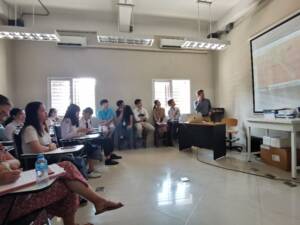On Tuesday 28th March, Vincent Herbreteau, researcher at the French National Research Institute for Sustainable Development (IRD) and Head of the Geohealth Group of Institut Pasteur du Cambodge, and Emilie Carlot, ECOMORE II Project Coordinator , visited their colleagues at the Institut Pasteur du Laos to present two platforms developed in the framework of ECOMORE 2 Climate working group.
 After being warmly greeted by Institut Pasteur du Laos’ Director Paul Brey, Vincent presented his team work to an audience consisting of internal scientists and students from the University of Health Sciences and the National University of Laos. In summary, the two activities consisted in modeling the present and future distribution of Aedes aegypti, Aedes albopictus mosquitoes, as well as leptospirosis in order to better understand how they will be impacted by the future climate changes up to 2100. The context, methodology and objectives behind the models were explained extensively before a brief tutorial of the Climate platform was given. Vincent then went on to describe how the analysis of environmental factors associated to the onset of leptospirosis cases helped produce the LeptoYangon platform, a tool to monitor in near real time the suitable environment for leptospirosis transmission in the capital of Myanmar.
After being warmly greeted by Institut Pasteur du Laos’ Director Paul Brey, Vincent presented his team work to an audience consisting of internal scientists and students from the University of Health Sciences and the National University of Laos. In summary, the two activities consisted in modeling the present and future distribution of Aedes aegypti, Aedes albopictus mosquitoes, as well as leptospirosis in order to better understand how they will be impacted by the future climate changes up to 2100. The context, methodology and objectives behind the models were explained extensively before a brief tutorial of the Climate platform was given. Vincent then went on to describe how the analysis of environmental factors associated to the onset of leptospirosis cases helped produce the LeptoYangon platform, a tool to monitor in near real time the suitable environment for leptospirosis transmission in the capital of Myanmar.
In the afternoon, Vincent and Emilie, accompanied by Damien Philippon, in charge of the development of the dengue outbreak simulator and by scientists from Institut Pateur du Laos, namely: Cécile Troupin, Responsible of Medical Virology and Rabies Group, Somphavanh Somlor scientist in the Virology Unit and Thonglakhone Xaybounsou, Junior Scientist in the Medical Virology and Rabies Group. They all met at the National Center for Laboratory and Epidemiology (NCLE), Dr. Bounthanom Sengkeopraseuth, Chief of Epidemiology, Mrs. Amphai Khamsing, Epidemiology Staff), Mr. Kheam Boutsamay, SSA (WHO), and Vasco Carvaho (WHO).
 Comparably to the morning session, Vincent presented both the Climate and LeptoYangon platforms and the methodology which helped shape these models. Damien took the floor to present the dengue outbreak simulator which was under development in the Lao PDR.
Comparably to the morning session, Vincent presented both the Climate and LeptoYangon platforms and the methodology which helped shape these models. Damien took the floor to present the dengue outbreak simulator which was under development in the Lao PDR.
This tool was thought to model virological, entomological, meteorological and environmental data to predict incidence of dengue in Vientiane Prefecture on a short-time period (weekly time scale). The simulator is successful in forecasting the presence or absence of dengue fever in villages, but however, due to the lack of overlapping data (land cover, weather, mobility, census, epidemiology etc.) throughout the years, the model couldn’t be trained to properly quantify the incidence of dengue. The discussion session following the presentation allowed Vasco to introduce his team’s efforts to build the platform in Lao PDR throughout the past years. Indeed, the reporting of data has transitioned from hand filling excel sheets to a digitalized and operational platform in 2021. Vasco also briefly described WHO’s Early Warning, Alert and Response System (EWARS) which is designed to improve disease outbreak detection in emergency settings, such as in countries in conflict or following a natural disaster.
In conclusion of the meeting, Dr. Sengkeopraseuth kindly thanked the delegation for their visit and valuable presentations and reaffirmed NCLE’s support in ECOMORE 2 project.



Add Comment